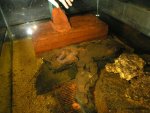Siren intermedia reproduction
Thank you all. I think the reproduction is external, as many eggs are not fertilized (same problem sometimes with Hynobiids). There were about 60 eggs laid in a single piece of java moss, deeply under a stone. There might be more eggs, but I prefer not to look there for the moment. The animals are a pair who lived in the tank for 3 years. The tank has some slow flowing water and is 1,80 m by 1 m. Water level is 0,40 m. Temperature is from 6 to 18°C. I saw one of the animals crawling vigorously under the stone, maybe to fertilize eggs, maybe for mating, or just to oxygenate eggs. It is difficult to say. Key criterias seem to be low temperatures, at least for a period, huge quantity of clean water, and big stones or logs deep in the water. This species is the true intermedia from Eastern coastal plain, very different from the nettingi form from more central areas and Gulf of Mexico (no spots, no clear yellowish band along the head, small size, see the photo in my book).



